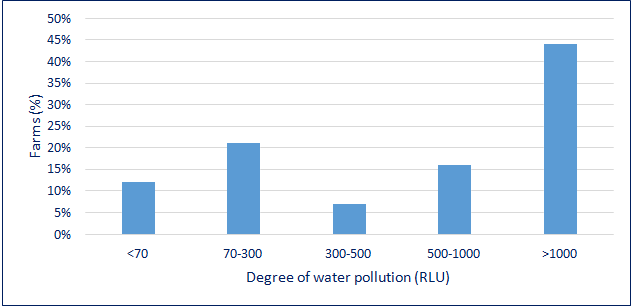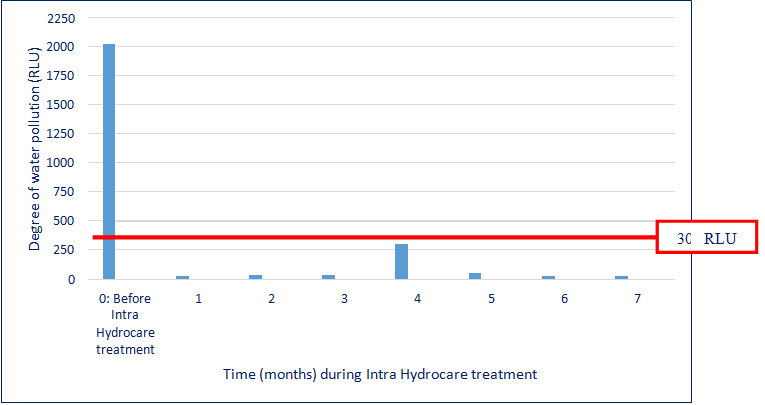Abstract
Water is an essential nutrient for poultry and a good water quality is essential for good performance of the flock. However, the water quality in farms is often neglected, leading to the formation of biofilm in the pipelines. This biofilm not only contains pathogenic micro- organisms that can transmit rapidly over the entire farm by the watering system. It also reduces the effectivity of water additives like antibiotics and vaccines, and retains and releases residues of these additives for a prolonged period of time. Therefore cleaning (removing biofilm) and disinfection (destroying micro-organisms) should be a top priority. Chlorine derivatives and acid based products only disinfect the water system, but do not break down and remove the biofilm. Intra Hydrocare has this dual property and has proven to be very effective in assuring a long term high water quality. When the incoming water is of good quality and the water lines are clean, the product can be used in a maintenance dose during 1 day a week.
The importance of good water quality
A bird can survive for weeks without feed but only a few days without water. Water is an essential nutrient for many functions within the body, such as carrying feed through the digestive tract and transporting nutrients (vitamins, minerals, amino acids) throughout the body. Additionally, water is required for enzymatic and chemical reactions in the body, regulation of body temperature, lubrication of joints and organs, and excretion of waste products from the body (Jéquier & Constant, 2010). Research has demonstrated that good water quality is essential for flock performance (do Amaral, 2004). Restricting the water consumption of broilers by 10% significantly correlates to a lower feed consumption and a lower weight gain. Furthermore, it has a negative influence on the intestinal weight and villi height of the animals (Viola et al., 2009).
Even though the importance of high water quality in the agricultural sector has been proven, the drinking water quality of farm animals is often neglected. On many farms the drinking water is contaminated with pathogenic bacteria, which can attach to the inner surface of the drinking line and start the formation of a biofilm (LeJeune et al., 2001). Such biofilm restrains the water flow, causes corrosion and leakages, and contaminates the water with detaching bacteria and other organic material. Additionally, biofilm can reduce the effectiveness of water-added antibiotics and vaccines. Our own studies demonstrate that contaminated water lines can absorb up to 25% of added antibiotics, and research of the Dutch Animal Health Service indicated that antibiotic residues are released from these lines for even 20 weeks after administration (Vijhe & Fabri, 2014)
In the agricultural sector many animals have access to the same water source. This is especially a large problem for the poultry sector, where thousands of animals are housed together. This facilitates a rapid transmission of bacterial diseases caused by Mycroplasma gallisepticum, Escherichia coli, Salmonella spp., Campylobacter spp., and Pasteurella multocida, viral diseases such as Newcastle disease, infectious bronchitis, infectious bursal disease virus, egg drop syndrome, Marek’s disease, and avian influenza, and protozoan diseases by the drinking water system (Australian National Water Biosecurity Manual, 2009 and Do Amaral, 2004).
Disinfection without cleaning is not sufficient
To guarantee a high and consistent water quality, both cleaning and disinfecting are important. However, many commonly used products on water lines only have disinfecting properties (Gomes et al., 2016). Chlorine derivatives (chlorine, chlorine dioxide and salt electrolysis into chlorine and sodium) only disinfect, and acid based products (like acidifiers or peracetic acid) are only able to maintain a constant microbiological status. If a biofilm is present, those agents reacts with the surface and kill or reduce the amount of pathogens on the biofilm, but do not breakdown or remove the biofilm itself. If the water is e.g. chlorinated, micro-organisms will remain inside the biofilm, and pollute the entire water system the moment the chlorine derivative is removed from the water. In addition, the use of chlorine derivatives requires gradually increasing dosage in order to keep the same degree of disinfection.
A more efficient and long term solution is a product that disinfects and cleans the drinking water system simultaneously. Intra Hydrocare is a water-based solution of 590 g/l hydrogen peroxide and activated silver. It has proven efficacy by European biocidal product regulations (BPR) in PT02 (disinfectants), PT03 (veterinary), PT04 (food & feed) and PT05 (drinking water) applications. These registrations also implicate that the product is safe for animals, equipment, and environment. Furthermore Intra Hydrocare has no negative effect on the taste of the water. This is beneficial, because an abnormal water taste can relate to a lower water intake, which is the case when chlorine derivatives or acid products are used. This was confirmed by a recent study in two houses with 52.000 broilers at a multinational integrator in New Zealand. One house was treated with chlorine dioxide and one house with the Intra Hydrocare. The broilers from the house treated with chlorine dioxide were drinking 78 ml/broiler less in the first week and 382 ml less measured at 41 days compared to the broilers from the house treated with Intra Hydrocare. The additional water intake resulted in an improved feed conversion rate (FCR) of 1.5 points and an 77 gram weight gain.
The costs of sanitizing water systems
The water consumption of broilers and layers is 1.8 times higher than their feed consumption, and this increases even further when then outside temperature increases. For a house with 20,000 broilers, the average cost of feed is around € 25,000 (NZ$ 40,000). Cleaning the drinking system and guaranteeing clean water for the whole round will cost only € 25-50 (NZ$40-80), which is 0.1-0.2% of the total feed costs. The low costs and the previously described importance of high water quality should make cleaning and disinfecting water systems a top priority.
Intra Hydrocare in practise: dosing 1 day a week
The water quality can be measured by sending samples to a laboratory for microbiological analysis, or by using the Intra Clean Quick scan kit. The last contains a device that measures the ATP content originating from living organisms, which is expressed in relative light units (RLU, table 1).
Table 1. Water quality values in Relative Light Units (RLUs) and their definition.
| RLU value | Definition |
| <70 | Suitable for human consumption |
| <300 | Suitable for animal consumption |
| 300 – 500 | Monitoring advised |
| 500 – 1000 | Action required |
| >1000 | Immediate action required |
As can be seen in table 1, RLU values below 300 are suitable for animal consumption. In practise, this is often not the case. A database containing information on the RLU values measured at the nipple of thousands of measuring points in poultry farms in 2015 and 2016, gives an overview of the average water quality. The results (Figure 1) show that 33% was suitable for animal consumption, 23% required monitoring or action and 44% required immediate action because the water was of such poor quality that animal health and performance were affected.

The effectiveness of Intra Hydrocare is shown in a case study on a research breeder farm which was categorized to the >1,000 RLU group. With an RLU value of 2,019 before treatment, this farm had a severely polluted water system. The results of dosing Intra Hydrocare at the maintenance level (1 day a week) over a 7 month period are shown in Figure 2. After cleaning and rinsing the RLU values dropped to the level suitable for animal consumption. With the exception of the 4th month, when probiotics and a vaccine were formerly administered, all RLU values are even suitable for human consumption

Where chlorine derivatives and acid based products have to be dosed continuously, Intra Hydrocare is able to keep a system with good quality incoming drinking water clean with a maintenance dose of 1 day a week after one initial cleaning session. Besides the savings on sanitising product and labour, it also provides freedom for the poultry farmer to dose dietary feeding supplements on the remaining 6 days
Gerwen Lammers, Ph.D.; Daisy Roijackers, M.Sc.; Marc Spackler, M.Sc.; Carly Vulders, B.Sc., Intracare B.V., Voltaweg 4, 5466 AZ, The Netherlands www.intracare.nl















